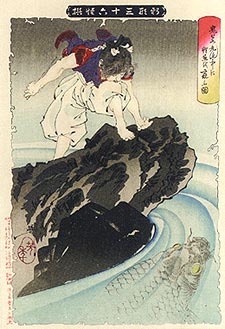

Early & Late Editions
|
The final series by Tsukioka Yoshitoshi (月岡芳年), Shinkei sanjûrokkaisen ("New Forms of Thirty-six Ghosts"), was first published by Sasaki Toyokichi between April 1889 and July 1892. Yoshitoshi became ill and would die before the last three designs of the set were published, so there is a possibility that he might have been assisted by his students Toshikata (1866-1908) and Toshihide (1863-1925), although the extent of their involvement is unknown. Except for at least one design (see Oniwakamaru below), the title cartouches in the prints from the first edition have three colors, distinguishing them from later impressions bearing only two colors in the cartouches. Even early impressions differ in the particular three colors chosen for the cartouches; for example, the pink-blue-yellow scheme in the figure on the left was changed to pink-blue-violet in some printings. A similar situation exists for later editions — impressions are known in both pink-yellow and pink-green cartouche printings. All the prints have black cartouches along the top with the series title left unprinted in white reserve (possibly suggestive of funerary script). The rough edges of the borders represent an artistic convention for antique, insect-eaten paper edges.
Early (shôzuri, 正摺) and Later Editions (atozuri, 後摺)
|
Early impression: 3-color cartouche / |
Later impression: 2-color cartouche / |
The images above illustrate what is probably the most poignant design from the series, Sarayashiki Okiku no rei ("The Ghost of Okiku at the Dish Mansion"), engraved by Chokusan and first published in the eighth month of 1890. The tale is one of the best known of all Japanese ghost stories, but it varies in the details depending on the source of the story. In one version Okiku was a maid in the service of Aoyama Tessan, a high-ranking retainer of the child shogun Tokugawa Ietsugu (1709-16). When his wife breaks one of ten valuable Delft porcelain dishes entrusted to the family for safekeeping by Dutch merchants, she throws the pieces into a well to hide her guilt and accuses Okiku, who is shamed into drowning herself in the well. Thereafter her ghost counts aloud from one to nine, then lets out a pitiful wail. Ultimately, a family friend is enlisted to help, and one night, just as the Ghost recites "nine," he loudly says "ten," and the ghost never returns to the well. An alternate version based on the kabuki play Bancho Sarayashiki ("The Dish Mansion at Bancho") has Aoymama trying to seduce Okiku by stealing one of the dishes and threatening her with blame unless she acquiesces. She drowns herself and haunts the well as in the earlier version. Yoshitoshi's portrayal of Okiku is unusually sympathetic, particularly as ghosts were viewed as fearsome apparitions by nineteenth-century Japanese.
The quality of the printing in the image at the top left is superb, executed with subtle gradations and shadings to depict the translucent form of a ghost. Note especially the lower part of Okiku's figure, which fades into nothingness. She has no feet (a characteristic of all ghosts), and the well can be seen through her ethereal aspect. The impression in the figure above right illustrates the loss of subtlety that is so often the case with later printings of ukiyo-e designs. The shading is cruder and darker, as well as more uniform and less gradated, which gives Okiku's form more substance and contradicts Yoshitoshi's intention to effectively depict Okiku's translucent ghost.
Posthumous impression |
Publishing |
Meiji sanjûgonen |
|
|
The series "Thirty-Six Ghosts" was republished after Yoshitoshi's death by Matsuki Heikichi in February-March 1902; he sold the prints as complete sets. The colors were sometimes different from the first or lifetime editions, and the publishing dates were changed in the margins. An example of a print from the republished set is shown above, titled Oniwakamaru chichu ni rigyo o ukagau zu ("Picture of Oniwakamaru Observing the Great Carp in the Pool"). No impressions — original or posthumous — are known of this design with tricolor cartouches. The original edition was published on October 20, 1889; it was carved by Horiyû. Early impressions use softer bands of blue that intersect near the rock (see image at immediate left). Later lifetime printings can be distinguished by the few wide strokes of blue in the water. The posthumous impression is well done, but it lacks the subtlety of the earlier impressions. The scene depicts the legendary warrior-priest Musashibô Benkei, retainer of Minamoto no Yoshitsune (1159-89), the celebrated military genius and half-brother of the shogun. Benkei was known as a boy by the name Oniwakamaru ("Young Devil Child"). He is shown preparing to attack a giant carp swimming at the foot of the Bishamon waterfall. The monster fish had devoured his mother and Benkei would exact his revenge. ©1999-2019 by John Fiorillo |
BIBLIOGRAPHY
- Ing, Eric van den & Schaap, Robert: Beauty and Violence: Japanese Prints by Yoshitoshi 1839-1892. Eindhoven & Bergeyk: Haviland Press & The Society for Japanese Arts, 1992, pp. 88-89 & 141-143.
- Keyes, Roger & Kuwayama, George: The Bizarre Imagery of Yoshitoshi: The Herbert R. Cole Collection. Los Angeles: The Los Angeles County Museum of Art, 1980, pp. 80-81, fig. 42.
- Keyes, Roger: Courage and Silence: A Study of the Life and Color Woodblock Prints of Tsukioka Yoshitoshi: 1839-1892. (Volumes 1 and 2). [Doctoral Dissertation]. Ann Arbor: University Microfilms. 1983, pp. 488-91.
- Segi, Sinichi: Yoshitoshi: The Splendid Decadent. Tokyo: Kodansha, 1985, pp. 76-78 & 141-144; fig. 44.
- Stevenson, John: Yoshitoshi's One Hundred Aspects of the Moon. Redmond, WA: San Francisco Graphic Society, 1992.
- Stevenson, John: Yoshitoshi's Thirty-Six Ghosts. New York & Tokyo: Weatherhill, 1983, pp. 32-33 & 52-53; plates VII & XVII.
- Stevenson, John: Yoshitoshi's Women: The Woodblock-Print Series Fûzoku Sanjûnisô. Seattle: University of Washington Press, 1995 (revised edition).
Viewing Japanese Prints |




